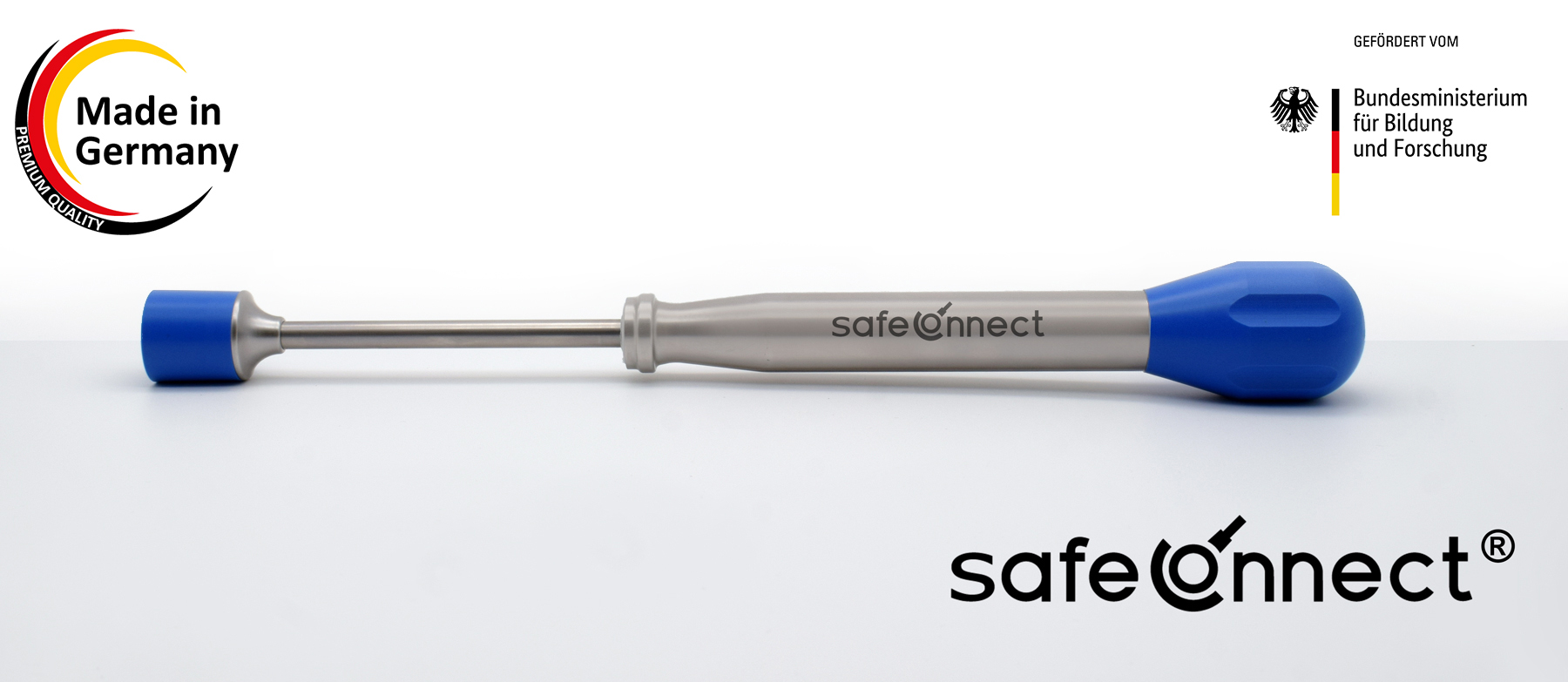safeConnect®

Die Streubreite der Einschlagkraft beim manuellen Setzen des Kugelkopfes ist intraoperativ enorm hoch und stellt daher ein Risiko dar. Wissenschaftliche Studien zeigen, dass die konstante Impaktierkraft großen Einfluss auf die Sicherheit der konischen Verbindung hat.
Unter kontinuierlicher wissenschaftlicher Evaluation wurde ein standardisiertes Impaktierverfahren entwickelt, welches ein reproduzierbares Fügen der konischen Verbindung mit optimaler Krafteinleitung gewährleistet und damit das manuelle Setzen des Kugelkopfes/Inlays mittels Hammer ablöst.
safeConnect ist damit das unverzichtbare Instrument für die Primär- und Revisionsendoprothetik.

Funktionsprinzip:
Das Instrument wird auf den Kugelkopf/Inlay formschlüssig aufgesetzt und einmalig in Achsrichtung der Prothese durchgedrückt. Eine präzise, konstante Fügekraft wird impulsartig ausgelöst und impaktiert die konische Verbindung.
Vorteile im Überblick:
- Standardisiertes, sicheres Verfahren
- Präzise, reproduzierbare Krafteinleitung
- Ein Instrument für alle Kugelköpfe und Inlays
- Einfaches OP-Handling, leichte Bedienbarkeit
- Wiederverwendbares Instrument
safeConnect - Die Innovation für die Hüftendoprothetik

Art.Nr. 740126 - Keramik-Inlay Stößel safeConnect

Funktion: Zum Lösen und Lockern festsitzender Keramikinlays
Einsatzbereich: Pfanne, Keramik
Funktionsprinzip safeConnect - Video
Die Problematik kurz erklärt: "Hart aber Fair" diskutiert...
Die Problematik kurz erklärt: "Hart aber Fair" diskutiert...
| Einzel- und Ersatzteile | |||||
| Art. Nr. | Bezeichnung | ||||
| 740100 | Instrument safeConnect | ||||
| 740120 | Kugelkopfaufsatz safeConnect | ||||
| 740124 | Aufsatz Inlay D22 mm safeConnect | ||||
| 740121 | Aufsatz Inlay D28 mm safeConnect | ||||
| 740122 | Aufsatz Inlay D32 mm safeConnect | ||||
| 740123 | Aufsatz Inlay D36 mm safeConnect | ||||
| 740126 | Keramik-Inlay Stößel safeConnect | ||||
Literatur zum Thema
[1] LEARMONTH, I.D., YOUNG, C., RORABECK, C. (2007).
The operation of the century: total hip replacement. Lancet. 370 (9597): S. 1508-19.
[2] KAUFMANN-KOLLE, P., WILLMS, G. (Göttingen 2011).
Qualitätsreport 2010. Gemeinsamer Bundesausschuss Berlin. AQUA – Institut für angewandte Qualitätsförderung und Forschung im Gesundheitswesen GmbH.
[3] KURTZ, S., ONG, K., LAU, E., MOWAT, F., HALPERN, M. (2007).
Projections of primary and revision hip and knee arthroplasty in the United States from 2005 to 2030. J Bone Joint Surg Am. 89 (4): S. 780-5.
[4] BISHOP, N., WITT, F., POURZAL, R., FISCHER, A., RUTSCHI, M., MICHEL, M., MORLOCK, M. (2013).
Wear patterns of taper connections in retrieved large diameter metal-on-metal bearings. J Orthop Res. 31 (7): S. 1116-22.
[5] LANGTON, D.J., SIDAGINAMALE, R., LORD, J.K., NARGOL, A.V.F., JOYCE, T.J. (2012).
Taper junction failure in large-diameter metal-on-metal bearings. Bone and Joint Research. 1 (4): S. 56-63.
[6] KOCAGOZ, S.B., UNDERWOOD, R.J., SIVAN, S., GILBERT, J.L., MACDONALD, D.W., DAY, J.S., KURTZ, S.M. (2013).
Does Taper Angle Clearance Influence Fretting and Corrosion Damage at the Head-Stem Interface? A Matched
Cohort Retrieval Study. Seminars in arthroplasty. 24 (4): S. 246-254.
[7] LAKSTEIN, D., KOSASHVILI, Y., BACKSTEIN, D., SAFIR, O., LEE, P., GROSS, A.E. (2010).
Revision total hip arthroplasty with a modular tapered stem. Hip Int. 20 (2): S. 136-42.
[8] MCMASTER, W.C., PATEL, J. (2013).
Adverse local tissue response lesion of the knee associated with Morse taper corrosion. J Arthroplasty. 28 (2): S. 375.e5-8.
[9] MEYER, H., MUELLER, T., GOLDAU, G., CHAMAON, K., RUETSCHI, M., LOHMANN, C.H. (2012).
Corrosion at the cone/taper interface leads to failure of large-diameter metal-on-metal total hip arthroplasties. Clin Orthop Relat Res. 470 (11): S. 3101-8.
[10] LAVERNIA, C.J., BAERGA, L., BARRACK, R.L., TOZAKOGLOU, E., COOK, S.D., LATA, L., ROSSI, M.D. (2009).
The effects of blood and fat on Morse taper disassembly forces. Am J Orthop (Belle Mead NJ). 38 (4): S. 187-90.
[11] REHMER, A., BISHOP, N.E., MORLOCK, M.M. (2012).
Influence of assembly procedure and material combination on the strength of the taper connection at the head-neck junction of modular hip endoprostheses. Clinical biomechanics (Bristol, Avon). 27 (1): S. 77-83.
[12] NASSUTT, R., MOLLENHAUER, I., KLINGBEIL, K., HENNING, O., GRUNDEI, H. (2006).
[Relevance of the insertion force for the taper lock reliability of a hip stem and a ceramic femoral head]. Biomed Tech (Berl). 51 (2): S. 103-9.
[13] COOK, S.D., MANLEY, M.T., KESTER, M.A., DONG, N.G. (1993).
Torsional resistance and wear of a modular sleeve-stem hip system. Clinical materials. 12 (3): S. 153-8.
[14] MUNIR, S., WALTER, W.L., WALSH, W.R. (2015).
Variations in the trunnion surface topography between different commercially available hip replacement stems. J Orthop Res. 33 (1): S. 98-105.
[15] GILBERT, J.L., BUCKLEY, C.A., JACOBS, J.J. (1993).
In vivo corrosion of modular hip prosthesis components in mixed and similar metal combinations. The effect of crevice, stress, motion, and alloy coupling. J Biomed Mater Res. 27 (12): S. 1533-44.
[16] KRETZER, J.P., JAKUBOWITZ, E., KRACHLER, M., THOMSEN, M., HEISEL, C. (2009).
Metal release and corrosion effects of modular neck total hip arthroplasty. Int Orthop. 33 (6): S. 1531-6.
[17] GOLDBERG, J.R., GILBERT, J.L. (2003).
In vitro corrosion testing of modular hip tapers. J Biomed Mater Res B Appl Biomater. 64 (2): S. 78-93.
[18] KHAN, M.A., WILLIAMS, R.L., WILLIAMS, D.F. (1999).
The corrosion behaviour of Ti-6Al-4V, Ti-6Al-7Nb and Ti-13Nb-13Zr in protein solutions. Biomaterials. 20 (7): S. 631-7.
[19] GRUPP, T.M., WEIK, T., BLOEMER, W., KNAEBEL, H.P. (2010).
Modular titanium alloy neck adapter failures in hip replacement--failure mode analysis and influence of implant material. BMC Musculoskelet Disord. 11: S. 3.
[20] GOLDBERG, J.R., GILBERT, J.L., JACOBS, J.J., BAUER, T.W., PAPROSKY, W., LEURGANS, S. (2002).
A multicenter retrieval study of the taper interfaces of modular hip prostheses. Clin Orthop Relat Res. 401: S. 149-61.




